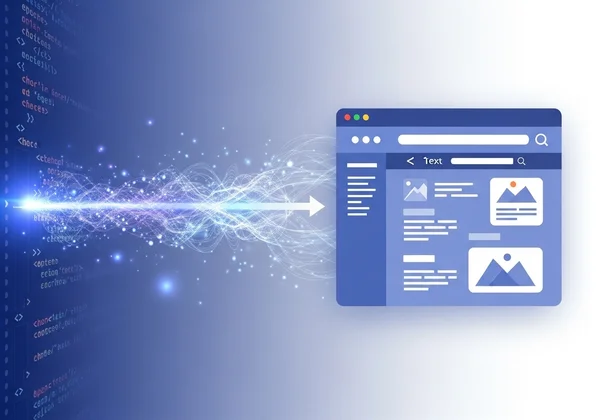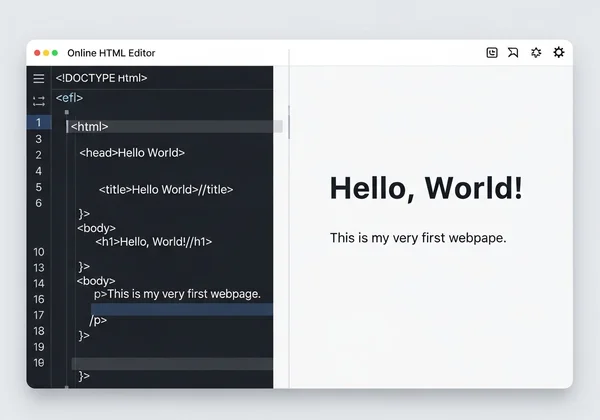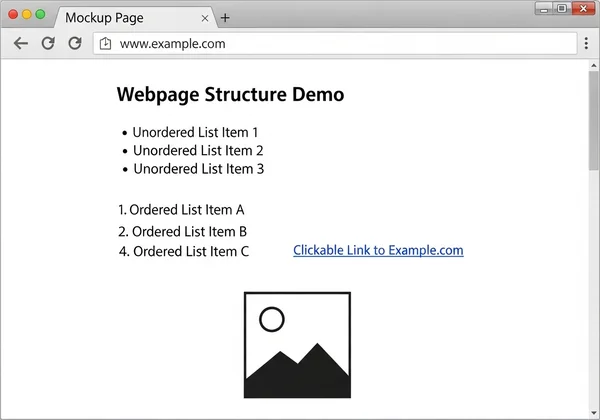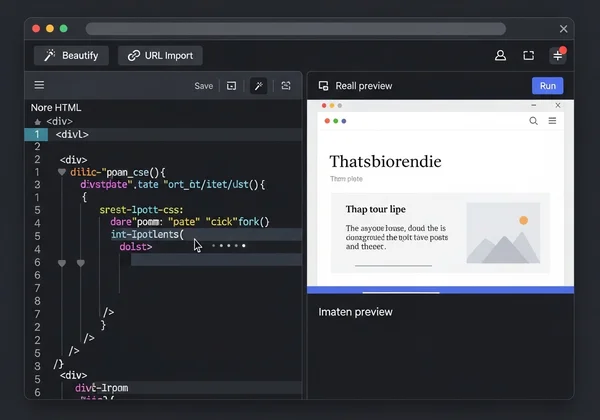Learn HTML Online Easily with Our Free HTML Viewer & Editor
Ready to build your first website? The world of web development might seem daunting, but it all starts with one fundamental language: HTML. This practical, step-by-step html tutorial for beginners will break down the absolute essentials, making it easy and fun for complete novices. You'll learn the building blocks of the web and discover how an online HTML editor can be your perfect learning companion for instant code practice and visual feedback.

What is HTML? Your First Steps into Web Structure
HTML, which stands for HyperText Markup Language, is the standard language used to create and structure the content of a webpage. Think of it as the skeleton of a website. Just as a skeleton provides the frame for a body, HTML provides the essential structure for text, images, and other elements you see on a webpage. It tells the browser what each piece of content is—a heading, a paragraph, a link, or an image.
The Language of the Web: Why HTML Matters
Every single website you visit, from massive social media platforms to personal blogs, is built upon a foundation of HTML. It is the universal language that all web browsers understand. Learning HTML is the non-negotiable first step for anyone interested in web development, web design, or even content management. It empowers you to understand how the web works and gives you the ability to create your own digital space from scratch.
Your First HTML Document: A Simple "Hello World" Example
Let's dive right in with the classic "Hello World" example. This simple document contains the most basic structure every HTML page needs. Don't worry about understanding every part just yet; the goal is to see it in action.
<!DOCTYPE html>
<html>
<head>
<title>My First Page</title>
</head>
<body>
<h1>Hello, World!</h1>
<p>This is my very first webpage.</p>
</body>
</html>
Now for the exciting part. Copy the code above and head over to our online HTML editor. Paste the code into the editor on the left, and you'll instantly see your first webpage appear in the preview panel on the right! This is the magic of a real-time HTML viewer.

Understanding HTML Elements, Tags, and Attributes
The code you just used is made up of several key components: elements, tags, and attributes. Mastering these concepts is crucial to building more complex and interactive web pages.
Unpacking Elements: From Paragraphs to Headings
An HTML element is an individual component of a webpage. It usually consists of a start tag, some content, and an end tag. For example, <p>This is a paragraph.</p> is a complete paragraph element. The <p> is the start tag, and the </p> is the end tag. The text in between is the content. Tags are the keywords in angle brackets that define how your content should be formatted.
Common elements include:
<h1>to<h6>: Headings of different sizes, with<h1>being the most important.<p>: Paragraphs for regular text.<a>: Anchor tags for creating links.
Adding Detail with Attributes: Enhancing Your Elements
Attributes provide additional information about an element and are always specified in the start tag. They usually come in name/value pairs like name="value". For instance, in a link element <a>, the href attribute specifies the URL the link should go to.
Here’s an example: <a href="[https://htmlviewer.cc](https://htmlviewer.cc)>Visit our website</a>. In this case, href is the attribute name, and `"https://htmlviewer.cc is the attribute value. Attributes are what make elements dynamic and functional.
Structuring Your Page: Essential HTML Tags for Layout
With the basics covered, let's explore some of the most common tags you'll use to add content and structure to your pages. As you go through these examples, remember to practice your code on our platform to see the immediate results.
Text Formatting: Bold, Italic, and Beyond
HTML offers simple tags to change the appearance of your text. To make text bold, you wrap it in <strong> tags. For italics, you use <em> (emphasized) tags. These not only change the look but also add semantic meaning for search engines and screen readers.
Example:
<p>This is <strong>important</strong> text, and this is <em>emphasized</em> text.</p>
Lists and Links: Navigating Your Content
Lists are perfect for organizing information. There are two main types: unordered lists (<ul>) for bullet points and ordered lists (<ol>) for numbered items. Each item within the list uses the <li> (list item) tag.
Example:
<ul>
<li>First item</li>
<li>Second item</li>
</ul>
<ol>
<li>First step</li>
<li>Second step</li>
</ol>
Images and Multimedia: Bringing Your Page to Life
A webpage without images can be dull. The <img> tag allows you to embed images. It's a self-closing tag and requires two key attributes: src (the source or URL of the image) and alt (alternative text for accessibility and SEO).
Example:
<img src="image-url.jpg" alt="A descriptive caption for the image">

Why Our Online HTML Editor is Your Perfect Learning Partner
Learning theory is one thing, but practice is what truly builds skill. Our HTML viewer was designed to be the ultimate sandbox for web learners, offering features that accelerate your understanding and make coding less intimidating.
Instant Feedback: Real-time Preview for Rapid Learning
The most significant challenge for beginners is connecting the code they write to the visual outcome. Our free online tool closes this gap with a live preview that updates instantly as you type. Change a heading, add a paragraph, or break an image link, and you'll see the result immediately. This rapid feedback loop is invaluable for learning cause and effect in coding.

Beautify & Clean Up: Making Your Code Readable
As your code gets more complex, it can become messy and hard to read. With a single click of the "Beautify" button, our tool will automatically format your HTML with proper indentation and spacing. This not only makes your code look professional but also helps you understand its nested structure—a critical skill for debugging.
URL Import: Learning from Real-World Websites
Ever wondered how your favorite website is built? With our URL Import feature, you can paste any website's URL and instantly load its HTML source code into the editor. You can then use the Beautify feature to clean it up and study its structure. This is an incredibly powerful way to learn from professional, real-world examples and see how experienced developers structure their pages.
Embrace Your Web Development Journey Today!
You've now taken your first significant steps into the world of web development, learning what HTML is, how to structure a basic document, and how to use essential tags to add content. Most importantly, you know that learning doesn't have to happen in a vacuum.
The key to mastery is consistent practice. Use what you've learned today and continue experimenting. Challenge yourself to recreate simple webpages or build a personal "about me" page. With every line of code you write, you'll build confidence and skill.
Ready to put your knowledge into practice? Head over to our HTML editor online now and start building. Your web development journey has just begun!
Frequently Asked Questions About Learning HTML
What exactly is HTML and why do I need to learn it?
HTML (HyperText Markup Language) is the foundational code used to structure the content on a webpage. You need to learn it because it is the essential first step in web development, design, and even digital marketing. It's the skeleton upon which all websites are built.
How can I view the HTML code of any website to learn from it?
Most browsers have a "View Page Source" option. However, the code can be messy. A simpler way is to use our tool's URL Import feature. Just paste a website's address into our online HTML viewer, and it will fetch the clean, beautified code for you to study and learn from.
Can I test my HTML code without downloading any software?
Absolutely! That's precisely what online editors are for. You can write, edit, and preview your HTML code directly in your browser without any setup or installation. It's the quickest and easiest way to start coding.
What is the easiest way to see changes to my HTML code instantly?
The easiest way is by using a live HTML viewer. Our free online HTML tool provides a split-screen view where you can type your code on one side and see the visual webpage render in real-time on the other. This instant feedback is perfect for learning and debugging.